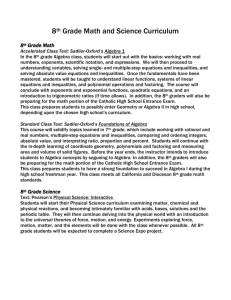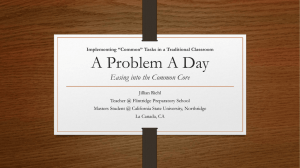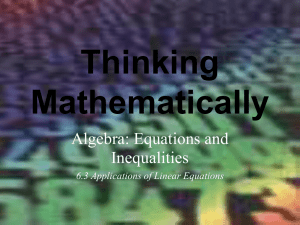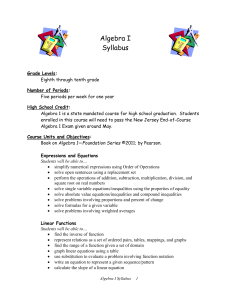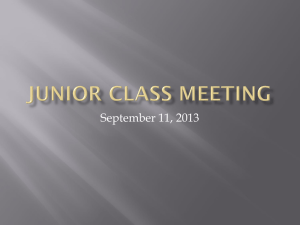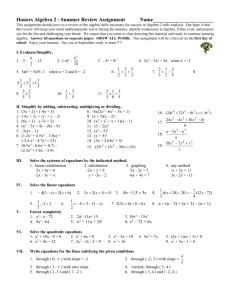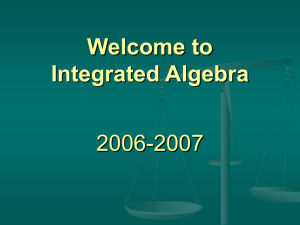Math in Fashion: Algebra EOC Questions
advertisement
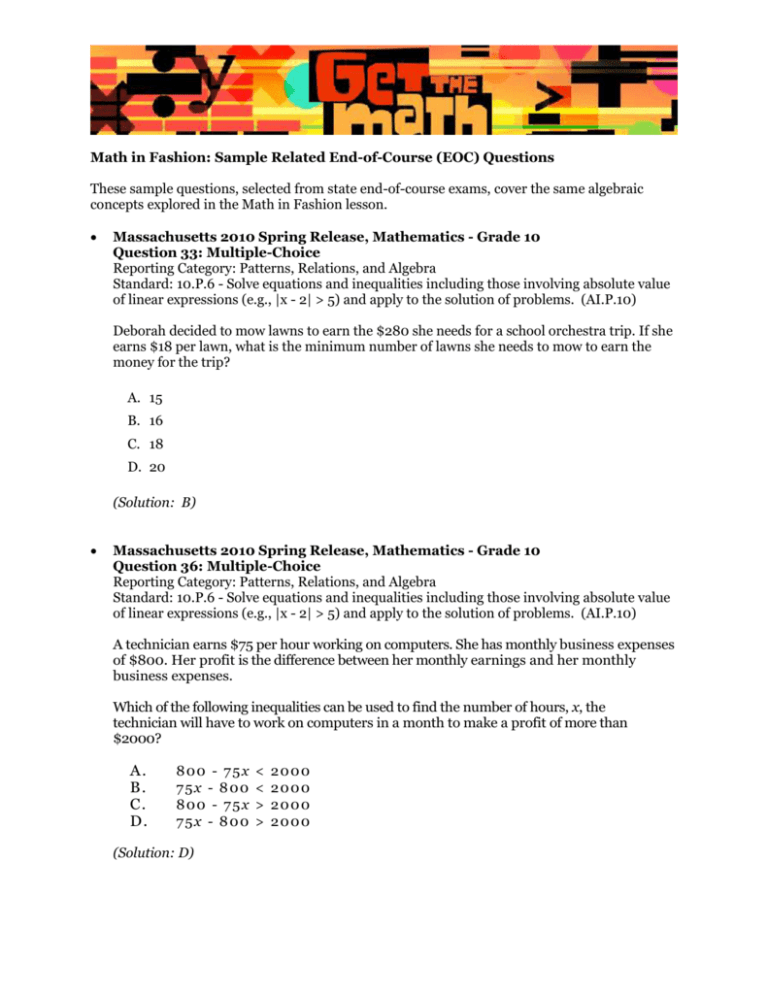
Math in Fashion: Sample Related End-of-Course (EOC) Questions These sample questions, selected from state end-of-course exams, cover the same algebraic concepts explored in the Math in Fashion lesson. Massachusetts 2010 Spring Release, Mathematics - Grade 10 Question 33: Multiple-Choice Reporting Category: Patterns, Relations, and Algebra Standard: 10.P.6 - Solve equations and inequalities including those involving absolute value of linear expressions (e.g., |x - 2| > 5) and apply to the solution of problems. (AI.P.10) Deborah decided to mow lawns to earn the $280 she needs for a school orchestra trip. If she earns $18 per lawn, what is the minimum number of lawns she needs to mow to earn the money for the trip? A. 15 B. 16 C. 18 D. 20 (Solution: B) Massachusetts 2010 Spring Release, Mathematics - Grade 10 Question 36: Multiple-Choice Reporting Category: Patterns, Relations, and Algebra Standard: 10.P.6 - Solve equations and inequalities including those involving absolute value of linear expressions (e.g., |x - 2| > 5) and apply to the solution of problems. (AI.P.10) A technician earns $75 per hour working on computers. She has monthly business expenses of $800. Her profit is the difference between her monthly earnings and her monthly business expenses. Which of the following inequalities can be used to find the number of hours, x, the technician will have to work on computers in a month to make a profit of more than $2000? A. B. C. D. 800 - 75x 7 5x - 8 0 0 800 - 75x 7 5x - 8 0 0 (Solution: D) < < > > 20 0 0 20 0 0 20 0 0 20 0 0 Massachusetts 2010 Spring Release, Mathematics - Grade 10 Question 17: Open Response Reporting Category: Patterns, Relations, and Algebra Standard: 10.P.7 - Solve everyday problems that can be modeled using linear, reciprocal, quadratic, or exponential functions. Apply appropriate tabular, graphical, or symbolic methods to the solution. Include compound interest, and direct and inverse variation problems. Use technology when appropriate. (AI.P.11) Question 17 is an open-response question. o BE SURE TO ANSWER AND LABEL ALL PARTS OF THE QUESTION. o Show all your work (diagrams, tables, or computations) in your Student Answer Book. o If you do the work in your head, explain in writing how you did the work. When Nuri buys an item from a catalog, the total amount he pays is made up of the following three amounts of money: o the price of the item o sales tax of 5% of the price of the item o a fixed shipping fee that is always the same regardless of the cost or size of the order Nuri bought a game with a price of $100 from the catalog. a. What was the sales tax, in dollars, that Nuri paid on the game? Show or explain how you got your answer. b. The total amount, including the sales tax and the shipping fee, that Nuri paid for the game was $120. What was the shipping fee, in dollars? Show or explain how you got your answer. c. Nuri bought an item with a price of $400 from the catalog. What is the total amount he paid in dollars, including the sales tax and the shipping fee? Show or explain how you got your answer. d. Write an equation that expresses the relationship between y, the total amount paid for an item from the catalog including the sales tax and shipping fee, and x, the price of the item. Show or explain how you got your equation. (Solutions: a. $5; b. $15; c. $435; d. y = 1.05 x + 15) Scoring Guide and Sample Student Work Score Description 4 The student response demonstrates an exemplary understanding of the Patterns, Relations, and Algebra concepts involved in solving an everyday problem that can be modeled by a linear equation. The student writes an equation to represent the total cost of an item, including sales tax and a shipping fee. 3 The student response demonstrates a good understanding of the Patterns, Relations, and Algebra concepts involved in solving an everyday problem that can be modeled by a linear equation. Although there is significant evidence that the student was able to recognize and apply the concepts involved, some aspect of the response is flawed. As a result, the response merits 3 points. 2 The student response demonstrates a fair understanding of the Patterns, 2 Relations, and Algebra concepts involved in solving an everyday problem that can be modeled by a linear equation. While some aspects of the task are completed correctly, others are not. The mixed evidence provided by the student merits 2 points. 1 The student response demonstrates a minimal understanding of the Patterns, Relations, and Algebra concepts involved in in solving an everyday problem that can be modeled by a linear equation. 0 The student response contains insufficient evidence of an understanding of the Patterns, Relations, and Algebra concepts involved in solving an everyday problem that can be modeled by a linear equation to merit any points. California Standards Test: Algebra I Released Test Questions 2006 Question 15: Multiple Choice Reporting Cluster: Number Properties, Operations, and Linear Equations Reporting Cluster Standard 5.0: Students solve multistep problems, including word problems, involving linear equations and linear inequalities in one variable and provide justification for each step. The cost to rent a construction crane is $750 per day plus $250 per hour of use. What is the maximum number of hours the crane can be used each day if the rental cost is not to exceed $2500 per day? A. B. C. D. 2.5 3.7 7.0 13.0 (Solution: C) California Standards Test: Algebra I Released Test Questions 2007 Question 16: Multiple Choice Reporting Cluster: Number Properties, Operations, and Linear Equations Reporting Cluster Standard 5.0: Students solve multistep problems, including word problems, involving linear equations and linear inequalities in one variable and provide justification for each step. What is the solution to the inequality x− 5 > 14? A. B. C. D. x>9 x >19 x<9 x <19 (Solution: B) 3 Massachusetts 2008 Spring Release, Mathematics - Grade 10 Question 20: Open Response Reporting Category: Patterns, Relations, and Algebra Standard: 8.N.12 Select and use appropriate operations—addition, subtraction, multiplication, division, and positive integer exponents—to solve problems with rational numbers (including negatives). • BE SURE TO ANSWER AND LABEL ALL PARTS OF EACH QUESTION. • Show all your work (diagrams, tables, or computations) in your Student Answer Booklet. • If you do the work in your head, explain in writing how you did the work. Glenn sells clothing at his store. He changes some prices each month. a. The original price of a jacket was $30. Glenn increased the price by 10%. What is the new price of the jacket after the increase? Show or explain how you got your answer. b. The original price of a pair of sneakers was $50. o Glenn increased the price by 20% in April. o He then increased the price again by 20% in July. What is the new price of the sneakers after both increases? Show or explain how you got your answer. c. The original price of a shirt was $16. o Glenn increased the price by 25% in April. o He then decreased the price by 30% in July. Is the final price of the shirt the same as if the original price had been decreased by 5%? Show or explain how you got your answer. d. The original price of a coat was $80. Glenn increased the price to $100. By what percent did the price increase? Show or explain your work. (Solutions: a. $33; b. $72; c. No, the final price is not the same as if the original price had been decreased by 5%; d. The price is increased by 25%) Scoring Guide and Sample Student Work Score 4 Description The student response demonstrates an exemplary understanding of the Number Sense and Operations concepts involved in selecting and using appropriate operations to solve percent increase and percent decrease problems. Given the percent of increase or decrease, the student correctly calculates the new prices; then the student calculates the percent of increase given the original and new prices. 3 The student response demonstrates a good understanding of the Number Sense and Operations concepts involved in selecting and using appropriate operations to solve percent increase and percent decrease problems. Although there is significant evidence that the student was able to recognize and apply the concepts involved, some aspects of the response are flawed. As a result, the response merits 3 points. 2 The student response demonstrates a fair understanding of the Number Sense and Operations concepts involved in selecting and using appropriate operations to solve percent increase and percent decrease problems. While some aspects of the task are completed correctly, others are not. The mixed evidence provided by the student 4 merits 2 points. 1 The student response demonstrates a minimal understanding of the Number Sense and Operations concepts involved in selecting and using appropriate operations to solve percent increase and percent decrease problems. 0 The student response contains insufficient evidence of an understanding of the Number Sense and Operations concepts involved in selecting and using appropriate operations to solve percent increase and percent decrease problems to merit any points. 5


